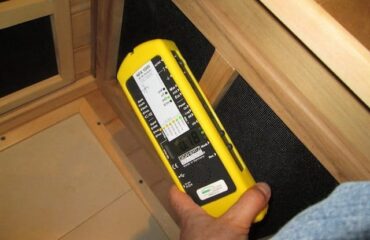Mercury Spills in our Homes – How to Clean Up

Mercury Spills in Our Homes
Accidental Release and Clean-up of Small Quantities of
( less than 3 grams)
Mercury is a unique metal and has some rather amazing properties. It’s the only metal that is a liquid at room temperature. It was originally described as “silver water” in ancient Greece. Because it is both a metal and is liquid at room temperature mercury is an excellent motion switch. When the liquid metal is caused to move and make contact with two or more wires, we have an electrical switch. We’ll find this liquid metal in many home thermostats. What should we do if mercury spills in our homes?
Mercury is also very toxic. Exposure to the smallest amount will result in brain and nervous system damage in the unborn. Inhaling mercury vapors will destroy lung tissue. Small amounts of mercury have been used medicinally, before we understood very much about this element that occupies the 80th position in the Periodic Chart of the Elements. Mercury is also used as a preservative in vaccines and at one time was used as a topical antiseptic. If you remember “mecurichrome” you probably remember “gas wars” and “pet rocks” too. Mecurichrome was a solution of alcohol and mercury-bromine, with known property of staining clothing. I personally recall not knowing which hurt worse; the bicycle-crash road rash or the little tiny drops of red fire that Mom would dispense from that eye dropper onto my wounds. Given what we know about chromium and mercury today, I seriously doubt those two words would be joined again for any commercial purpose other than “Defense“or “National Security”.
Mercury is also very useful as a component in lighting because as a gas it also conducts electrical current. We’ll find “mercury vapor” and “sodium vapor” lights in high lighting- demand environments. We’ve all grown up around florescent “tube” lights in our schools, work and homes. Recently we’ve been introduced to yet another type of mercury-containing florescent light illumination source: the compact florescent light bulb (CFL). These bulbs directly replace our older incandescent bulbs without having to change the light fixture itself. These new “bulbs” are drastically more efficient than the older ones. One CFL bulb will last as long as 8 to 15 “regular” bulbs and will do so while consuming as little as 25% the current that incandescent bulb would require to emit the same amount of light. Now that almost every home has these mercury containing CFL lights we need to know what to do with mercury spills in our homes.

Mercury Mines & Estuaries
The majority of electricity produced in America today is the result of burning of coal. Unfortunately, mercury is a contaminate of much of this coal, and is released in the smoke stack emissions of these generator plants, from which it enters the food chain. As a result, at least in part, is that fish consumption by pregnant women must be restricted to avoid damage to the unborn and to the mother herself. Mercury levels can build-up in our bodies and can be difficult to remove. Mercury can cause nervous system damage and is especially harmful to the developing brains of babies. If we buy and use CFL’s we’re reducing the demand on these generator plants and are burning less coal. Despite the fact that we’re buying small amounts of mercury with each CFL, the net result is a reduction of mercury released into the environment. We’re also reducing our carbon-footprint at the same time. Two points to consider.

Broken CFL’s with Mercury
If you have replaced your incandescent lights with CFL’s, you’re using less electricity over-all, but are buying small amounts of mercury, too. Eventually we all are going to come across a broken CFL, florescent tube, broken thermostat or thermometer. By properly collecting and retaining this small volume of mercury, we’re doing our part in reducing that mercury which would be headed toward a life cycle in our food chain. I am reminded of the expression: “Keep your friends close and your enemies closer”. Mercury has applications and uses for which there are few substitutes. Ironic as it seems that by using small amounts of this element, we can control or prevent the release of larger amounts of it elsewhere in our environment. We’re even impacting carbon emissions, too. So, please, use your CFL’s with pride. You’re reducing carbon footprint, impacting mercury emissions and saving money, too.
What To Do When Mercury Spills in Our Homes:
Living with mercury can be perfectly safe, despite it’s toxicity. It’s when something that contains mercury breaks and spills its contents in our homes or workplaces, that we have a problem. Cleaning up after a broken florescent tube, compact or not, is not the same as cleaning up after an incandescent bulb.
To better explain these steps, I’ll start with what not to do:
What Not To Do When Cleaning Up After Minor Mercury Spill
• Bare hands. Use disposable gloves. The gloves will have to be thrown away when done.
• Do Not Vacuum. Vacuuming will cause mercury vapors to be created or spread.
• Don’t dry sweep or brush—use other methods as described.
• Don’t spread it turn off furnace/shut doors, open windows, ventilate! What You Should Do Immediately After The Spill
• If the spill is more than ONE POUND ( 3 tablespoons) contact appropriate Response Agency. This is too much to handle. Most mercury spills in the home are significantly less than this amount. It’s important to know when to say “when”. Three tablespoons is “when”. (please note: Federal EPA suggests “2 to 3” tablespoons, while another source suggests 3 ).
• Don’t touch the mercury with bare hands. Avoid skin contact.
• Remove jewelry..mercury bonds permanently to gold and other metals.
What to DO when Mercury Spills:
• Do what you can to contain the spill. Keep it from migrating. Keep it out of cracks or crevices. Keep it from carpets if you can.
• Ventilate the room for 15 minutes: OPEN A WINDOW. Turn off the HVAC or Central Air immediately. Prevent “migration” of fumes to the rest of the house. Leave while this is airingout.
• Remove all persons and pets from the area. Only the person or cleaning the spill needs to be in the room or area. Materials Need For Clean-Up • stiff paper ( e.g. “index cards”)
• flashlight ( to spot even the smallest beads of mercury)
• packing or duct tape, or shaving cream and small paint brush whetted with shaving cream
• eye dropper or squeeze bulb for suctioning.
• plastic,vinyl or rubber gloves ( no skin contact—working with broken glass and mercury)
• sulfur powder (indicator)-available commercially or at garden stores.
• zip-lock bags
• plastic tub or container
Cleaning-Up The Spill
• This bears repeating: “Don’t Use A Vacuum” this will blow mercury vapors into the air, and will expose your respiratory system to mercury.
• Don’t use dry paper towels or dry brushes; this will spread the mercury out. • Don’t use household cleaners or chemicals; they could react with the mercury and create and release toxic gases.
• Don’t put any clean up materials down the drain or into the garbage. Call your waste hauler or city government to find out where you can take your “hazardous waste”.
• Never allow people with contaminated clothes to walk around the house.
• Secure the area until proper clean up has been performed. • Continue ventilating and completely wash hands, face, etc. Cleaning of Hard Surfaces (Linoleum, Vinyl, Tile, Hardwood): • Wearing gloves and working from the outside toward the middle, collect mercury beads toward the center using:
• Stiff Paper Cards (index cards, e.g.) gently pushing mercury beads
• Flashlight will help locate smallest beads. Mercury will travel surprising distance from point of spill.
• Using the eye-dropper, collect the mercury beads and deposit them in the dropper bottle or other sealable strong container.
• Use the eye-dropper to clean cracks or crevices. • Smallest particles can be collected with duct tape, and/or shaving cream on the end of brush bristles..keep brush wet with shaving cream, wipe off cream inside of a zip lock bag. Seal. Shaving cream can help create barrier to stop mercury beads.
• Double bag all debris, including tools, gloves and contaminated clothing..and label “Mercury Waste”. Store all bags in another container with a tight fitting lid. Label this container “Mercury-Do Not Open”.
Special Considerations: Carpeting that gets contaminated with mercury is recommended to be cut-out and discarded. Mercury is absorbed by the fibers of the carpeting and is impossible to remove.
“Indicator Powder” is pure sulfur. When mercury and sulfur combine, the result is a red or brown color. This powder, when in contact with mercury can stain cloth, carpeting and potentially wood flooring. The alternative is to rent a sensitive electronic analyzer, which is in excess of $350 per day. A carpet repair bill may be similar cost.
“Mercury Herding”; please keep in mind that mercury can move surprising distances with minimal effort or “push”. Work gently with mercury “beads”. When cleaning up with wet cloths, be mindful not to re-contaminate or to re-deposit mercury particles. Keep folding the moist wiping towel to contain dirt and debris. Deposit these wet clothes into zip lock bags.
“Dirty Shoes” Shoes that were worn during the clean-up can be sources of contamination. Don’t walk into the rest of the house with these shoes. Either place Hazardous Waste or wear shoe protection (something as simple as large plastic freezer storage bags worn over each shoe and secured with tape) BEFORE job begins.
“Dirty Clothes” Work clothes worn during clean-up can also become mercury-contaminated. Please consider wearing a tyvek type set of suit.
“Disposal” of small amounts of hazardous waste varies slightly from town to town, state to state and region to region. Contact your local waste hauler or authorities for specific dates, times and locations of operation for household hazardous waste collection.
“Mercury Free”. Consider purchasing mercury-free thermometers if you can, and then disposing the old thermometers appropriately.
Thank you for reading this article. If there are any questions or comments, please feel free to contact Geoff McPherson, Certified Asbestos Consultant (# 13-5111) and NIOSH-582 Air Sampling Technician/Phase Contrast Microscopist, at geoff@healthybuildingscience.com



